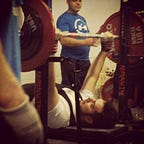Crossing the Great Green with High Intensity Interval Training
I’m rereading an old favorite novel called Lord of the Silver Bow by David Gemmell who, spins his own story of the Greek myth, the Trojan War.
I rarely reread books, especially novels but this one is one of the few exceptions.
Just as how many people weren’t interested in magic/monsters before J.K. Rowling, a great storyteller makes anything read exceptionally well.
This book was no exception.
It follows the story of the Trojan war in ancient Greece and Turkey.
Think of that story with the Trojan horse being drawn into an unsuspecting castle when in reality is filled with invaders, ready to attack.
Actually, the novel uses this as the backstory for a slightly different tale. It focuses on the culture of the ‘great green’ or Aegean sea.
It is filled with the culture of trade across huge empires of the time: the Hittites and the Egyptians.
In fact, the author goes into details about the life of the common person. In this case, a sailors/merchants trying to make a living with their own piece of the thriving sea trade economy.
Like I mentioned in a previous email, fiction isn’t real, but it can go into the emotions, thinking, and worldview of people in a way that non-fiction simply cannot.
And when it comes to historical fiction, we can get an insight into how people MIGHT have thought, being presented with the facts that we have knowledge of.
Sailing for months, living in nomadic conditions, docking your ship not on a proper dock but having to haul it from the sea onto a beach for the night, were aspects of the lives of any of these sailors.
And just as present, the real threat of combat was there.
Its hard to connect to a reality like that.
It seems so distant.
If you’re in the first world, especially the United States or Canada, it has been a long time since a major conflict has afflicted a mass population on the home front.
People enjoy real comfort so much so that it only takes a whisper to spread mass hysteria,
Intense moments of combat and calm before a storm aren’t as common in every day folks lives.
To farmers and seaman in the ancient era, this was always a threat.
You were always alert.
Speaking of alertness, rereading this book reminded me of how HIIT training has become popular and in many ways how it has a connection to a more violent and alert time.
Its quick.
Intense.
And challenges endurance while giving pretty high level of exertion.
What is HIIT training? Its Value and role.
HIIT or high intensity interval training consists of high intensity intervals aiming for high levels of exertion, followed by brief rest periods, cycled over again for several cycles.
Here’s an example:
6 reps of cleans
6 reps of Front squats
6 reps of Thrusters
6 reps of Back squats
6 reps of Deadlifts
6 reps of Rows
Rest 30 seconds
Repeat for six cycles.
It doesn’t have to be barbell movements of primal exercises either. Sprints with shorter rest periods (with the aim of never having your heart rate come to COMPLETE rest or rounds of sparring/boxing/kicking on a bag are similar.
- You’re exerting intense energy
- You’re never coming to complete resting heart rate
HIIT: Adding variety to your training
HIIT training allows you to train one of the three energy systems our bodies use.
The main energy systems:
- ATP-PC System — Used in short and intense movement lasting less than 10 seconds. Not much if any oxygen is utilized and relies on ATP.
- Lactic Acid System — Produces energy from muscle glycogen (stored glucose). Breakdown of glycogen happens in presence or absence of oxygen to make ATP. When there isn’t an adequate amount of oxygen, this system comes into effect. Usually this is for relatively short periods of high intensity activity but can cause a burning sensation.
- Aerobic System — Like the name says, it uses oxygen. With oxygen present, it acts very slowly to provide energy (ATP) and fuels long-lasting movement/exertion.
Ideally, we should all be training or experimenting with a variety of rep ranges for training and the same goes for the energy systems we train.
Different activities challenge different systems more so than others.
Long distance runners spend a lot of time in the aerobic system. While Weightlifting (the Olympic sport) is mostly in the ATP-PC system. By virtue of their sport of choice, they work on those areas to improve.
But, if you pull out and look at the years of training in in those specific areas, you’ll find that you need to get better in all the energy systems, on some level.
Otherwise you create a new weakpoint that caps progress.
If you build your creatine phosphate stores and do quick, explosive movements, you build power and total body attack man.
By improving your aerobic capacity, you lay a foundation to be able to do more work. And in any trait, you are trying to slowly do more work to create a stronger metabolic response.
And the anaerobic with improves blood flow and removal of waste products when you’re not getting enough oxygen to your muscles (think grinding through hard repetitions).
Being able to train all of these systems gives a well-rounded fitness.
Just as training various rep ranges and trying some different movement (whether it be physical hobbies like sports or a trade), variety in the energy systems can build a stronger vase as you continue to be physical across the decades.
